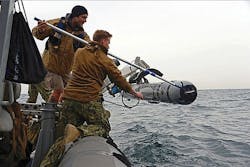Navy asks Hydroid to build extra versions of MK 18 mine-hunting UUV for underwater reconnaissance
INDIAN HEAD, Md. – Unmanned underwater vehicle (UUV) experts at Hydroid Inc. in Pocasset, Mass., will build MK 18 family of unmanned underwater vehicle (UUV) systems for the U.S. Navy under terms of a potential $47.9 million contract announced last week.
Officials of the Naval Surface Warfare Center (NSWC) Indian Head Explosive Ordnance Disposal Technology Division in Indian Head, Md., are asking Hydroid for additional MK 18 UUVs to detect, pinpoint, and neutralize underwater threats like sea mines.
The Navy Hydroid MK 18 UUV is a mine-hunting variant of the Hydroid REMUS 600, which Hydroid developed originally developed through funding from the Office of Naval Research (ONR) in Arlington, Va., to support the Navy's UUVs with extended endurance, increased payload capacity, and greater operating depth.
Navy officials are not releasing the number of MK 18 UUVs they are asking Hydroid to build. The contract, revealed in a 2 May justification and approval notice, is a one-year indefinite deliver, indefinite quantity deal with four one-year options.
The Mk 18 Mod 1 Swordfish UUV for underwater reconnaissance is capable of performing low-visible exploration and reconnaissance in support of amphibious landing; mine countermeasures operations such as search, classification, mapping, reacquire, and identification; hydrographic mapping at depths from 10 to 40 feet.
The UUV can navigate via acoustic transponders in long-baseline or ultra-short-baseline mode or via P-coded GPS. Its upward- and downward-looking acoustic digital velocity log improves dead-reckoning accuracy.
The MK 18 Mod 1 Swordfish UUV achieved full operational capabilities in 2008. Follow-on block upgrades will combine two separate UUV programs into the MK 18 family of systems to deliver improved detection capability against buried mines in high clutter environments.
The REMUS 600, on which the MK 18 UUV is based, can dive to depths of nearly 2,000 feet, and can operate on one battery charge for as long as 24 hours. The UUV is for mine countermeasures; harbor security; debris field mapping; search and salvage; scientific sampling and mapping; hydrographic surveys; environmental monitoring; and fishery operations. REMUS is short for Remote Environmental Measuring Unit S.
The torpedo-shaped REMUS 600 UUV is nearly 13 feet long and two feet in diameter. The unit weighs 622 pounds. It has dynamic focus side look sonar (SLS), a Neil Brown conductivity and temperature sensor (CT), WET Labs beam attenuation meter (BAM) optical sensor, Imagenex 852 pencil beam sonar for obstacle avoidance, and a WET Labs ECO fluorometer and turbidity measurement sensor.
Its communications suite consists of a long baseline acoustic communications, WiFi, Iridium satellite communications, and radio modem via gateway buoy. The UUV navigates by up- and down-looking acoustic Doppler current profiler; Doppler velocity log; Kearfott inertial navigation unit; compass; and GPS.
The REMUS 600 has a modular design to meet a variety of payloads. The UUV has a series of hull sections that can be separated for vehicle reconfiguration, maintenance, and shipping. It uses the Hydroid Vehicle Interface Program (VIP) for maintenance, checkout, mission planning, and data analysis.
Hydroid is a subsidiary of Kongsberg Maritime AS in Kongsberg, Norway. For more information contact Hydroid online at www.km.kongsberg.com/hydroid, or the NSWC Indian Head Explosive Ordnance Disposal Technology Division at www.navy.mil/local/nswciheodtd.
Ready to make a purchase? Search the Military & Aerospace Electronics Buyer's Guide for companies, new products, press releases, and videos

